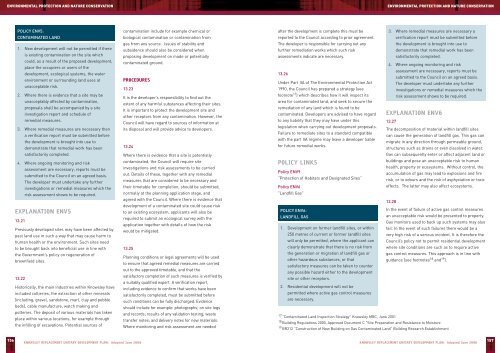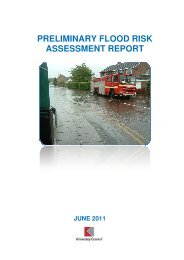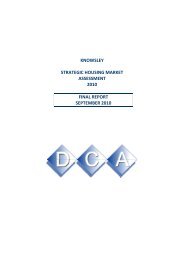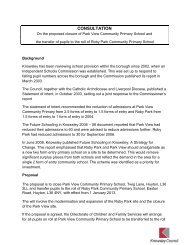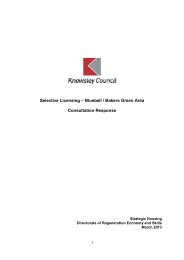Knowsley Replacement Unitary Development Plan - Knowsley Council
Knowsley Replacement Unitary Development Plan - Knowsley Council
Knowsley Replacement Unitary Development Plan - Knowsley Council
You also want an ePaper? Increase the reach of your titles
YUMPU automatically turns print PDFs into web optimized ePapers that Google loves.
ENVIRONMENTAL PROTECTION AND NATURE CONSERVATION<br />
ENVIRONMENTAL PROTECTION AND NATURE CONSERVATION<br />
POLICY ENV5:<br />
CONTAMINATED LAND<br />
1. New development will not be permitted if there<br />
is existing contamination on the site which<br />
could, as a result of the proposed development,<br />
place the occupiers or users of the<br />
development, ecological systems, the water<br />
environment or surrounding land uses at<br />
unacceptable risk.<br />
2. Where there is evidence that a site may be<br />
unacceptably affected by contamination,<br />
proposals shall be accompanied by a site<br />
investigation report and schedule of<br />
remedial measures.<br />
3. Where remedial measures are necessary then<br />
a verification report must be submitted before<br />
the development is brought into use to<br />
demonstrate that remedial work has been<br />
satisfactorily completed.<br />
4. Where ongoing monitoring and risk<br />
assessment are necessary, reports must be<br />
submitted to the <strong>Council</strong> on an agreed basis.<br />
The developer must undertake any further<br />
investigations or remedial measures which the<br />
risk assessment shows to be required.<br />
EXPLANATION ENV5<br />
13.21<br />
Previously developed sites may have been affected by<br />
past land use in such a way that may cause harm to<br />
human health or the environment. Such sites need<br />
to be brought back into beneficial use in line with<br />
the Government’s policy on regeneration of<br />
brownfield sites.<br />
13.22<br />
Historically, the main industries within <strong>Knowsley</strong> have<br />
included collieries, the extraction of other minerals<br />
(including, gravel, sandstone, marl, clay and pebble<br />
beds), cable manufacture, watch making and<br />
potteries. The deposit of various materials has taken<br />
place within various locations, for example through<br />
the infilling of excavations. Potential sources of<br />
contamination include for example chemical or<br />
biological contamination or contamination from<br />
gas from any source. Issues of stability and<br />
subsidence should also be considered when<br />
proposing development on made or potentially<br />
contaminated ground.<br />
PROCEDURES<br />
13.23<br />
It is the developer’s responsibility to find out the<br />
extent of any harmful substances affecting their sites.<br />
It is important to protect the development site and<br />
other receptors from any contamination. However, the<br />
<strong>Council</strong> will have regard to sources of information at<br />
its disposal and will provide advice to developers.<br />
13.24<br />
Where there is evidence that a site is potentially<br />
contaminated, the <strong>Council</strong> will require site<br />
investigations and risk assessments to be carried<br />
out. Details of these, together with any remedial<br />
measures that are considered to be necessary and<br />
their timetable for completion, should be submitted,<br />
normally at the planning application stage, and<br />
agreed with the <strong>Council</strong>. Where there is evidence that<br />
development of a contaminated site could cause risk<br />
to an existing ecosystem, applicants will also be<br />
required to submit an ecological survey with the<br />
application together with details of how the risk<br />
would be mitigated.<br />
13.25<br />
<strong>Plan</strong>ning conditions or legal agreements will be used<br />
to ensure that agreed remedial measures are carried<br />
out to the approved timetable, and that the<br />
satisfactory completion of such measures is verified by<br />
a suitably qualified expert. A verification report,<br />
including evidence to confirm that works have been<br />
satisfactorily completed, must be submitted before<br />
such conditions can be fully discharged. Evidence<br />
should include for example: photographs; on site logs<br />
and records; results of any validation testing; waste<br />
transfer notes; and delivery notes for new materials.<br />
Where monitoring and risk assessment are needed<br />
after the development is complete this must be<br />
reported to the <strong>Council</strong> according to prior agreement.<br />
The developer is responsible for carrying out any<br />
further remediation works which such risk<br />
assessments indicate are necessary.<br />
13.26<br />
Under Part IIA of The Environmental Protection Act<br />
1990, the <strong>Council</strong> has prepared a strategy (see<br />
footnote 17 ) which describes how it will inspect its<br />
area for contaminated land, and seek to secure the<br />
remediation of any land which is found to be<br />
contaminated. Developers are advised to have regard<br />
to any liability that they may have under this<br />
legislation when carrying out development proposals.<br />
Failure to remediate sites to a standard compatible<br />
with the part IIA regime may leave a developer liable<br />
for future remedial works.<br />
POLICY LINKS<br />
Policy ENV9<br />
“Protection of Habitats and Designated Sites”<br />
Policy ENV6<br />
"Landfill Gas"<br />
POLICY ENV6:<br />
LANDFILL GAS<br />
1. <strong>Development</strong> on former landfill sites, or within<br />
250 metres of current or former landfill sites<br />
will only be permitted, where the applicant can<br />
clearly demonstrate that there is no risk from<br />
the generation or migration of landfill gas or<br />
other hazardous substances, or that<br />
satisfactory measures can be taken to counter<br />
any possible hazard either to the development<br />
site or other receptors.<br />
2. Residential development will not be<br />
permitted where active gas control measures<br />
are necessary.<br />
3. Where remedial measures are necessary a<br />
verification report must be submitted before<br />
the development is brought into use to<br />
demonstrate that remedial work has been<br />
satisfactorily completed.<br />
4. Where ongoing monitoring and risk<br />
assessment are necessary, reports must be<br />
submitted to the <strong>Council</strong> on an agreed basis.<br />
The developer must undertake any further<br />
investigations or remedial measures which the<br />
risk assessment shows to be required.<br />
EXPLANATION ENV6<br />
13.27<br />
The decomposition of material within landfill sites<br />
can cause the generation of landfill gas. This gas can<br />
migrate in any direction through permeable ground,<br />
structures such as drains or even dissolved in water.<br />
Gas can subsequently enter or affect adjacent land or<br />
buildings and pose an unacceptable risk to human<br />
health, property or ecosystems. Without control, the<br />
accumulation of gas may lead to explosions and fire<br />
risk, or to odours and the risk of asphyxiation or toxic<br />
effects. The latter may also affect ecosystems.<br />
13.28<br />
In the event of failure of active gas control measures<br />
an unacceptable risk would be presented to property.<br />
Gas monitors used to back up such systems may also<br />
fail. In the event of such failures there would be a<br />
very high risk of a serious incident. It is therefore the<br />
<strong>Council</strong>’s policy not to permit residential development<br />
where site conditions are such as to require active<br />
gas control measures. This approach is in line with<br />
guidance (see footnotes 18 and 19 ).<br />
17 ”Contaminated Land Inspection Strategy” <strong>Knowsley</strong> MBC, June 2001<br />
18 Building Regulations 2000, Approved Document C “Site Preparation and Resistance to Moisture<br />
19 BR212 “Construction of New Building on Gas Contaminated Land” Building Research Establishment<br />
156<br />
KNOWSLEY REPLACEMENT UNITARY DEVELOPMENT PLAN: Adopted June 2006<br />
KNOWSLEY REPLACEMENT UNITARY DEVELOPMENT PLAN: Adopted June 2006<br />
157


